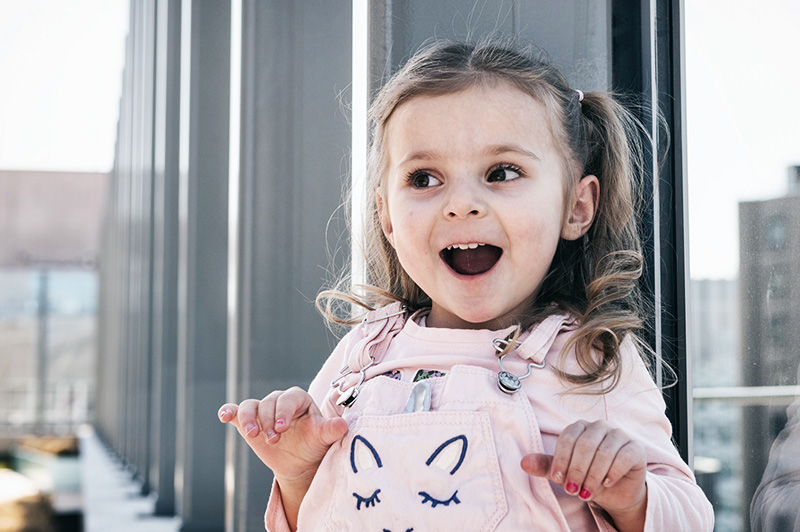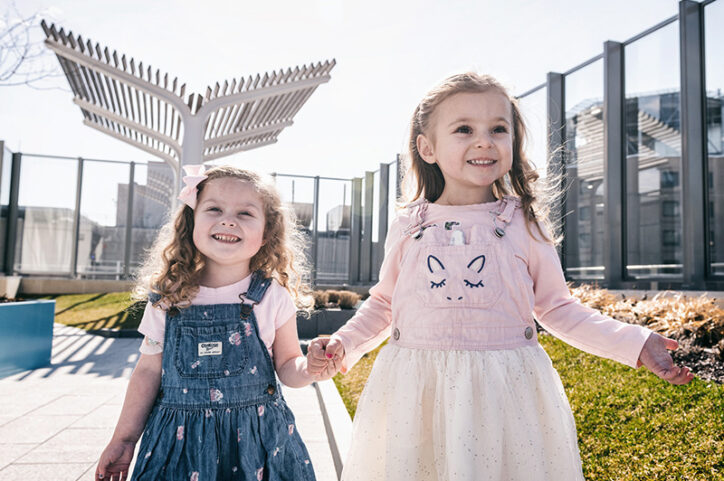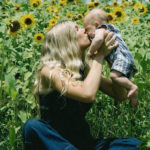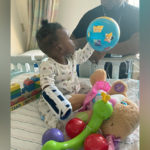‘A picture-perfect life’: Makayla is thriving with OEIS syndrome

On a sunny day this spring, Makayla Brisson was on a mission: to find the two bunny rabbit sculptures in the rooftop garden of Boston Children’s Hale Family Building. As much fun as she was having, Makayla was distracted: She was anxiously waiting for her best friend, Aubree. And as Aubree and her parents entered the garden, the two girls ran to each other, giggling.
While their relationship largely centers around the business of being 3 and 4, their parents have bonded about something else. Both girls were born with a rare colorectal and pelvic malformation called OEIS syndrome, in which many of the internal abdominal structures and organs are exposed outside the body. Also known as cloacal exstrophy, OEIS syndrome can include an omphalocele, cloacal exstrophy, imperforate anus, and spinal defects.
“Aubree’s mom and I connected online and the girls met each other as babies,” explains Makayla’s mother, Heather. “They’ve been friends ever since.”

Preparing for an OEIS diagnosis
Heather and her husband, Dustin, were at their 20-week ultrasound appointment when they learned that Makayla would be born with some type of colorectal and pelvic anomaly. “We didn’t know exactly what she would have, but OEIS was the most extreme end of the spectrum,” says Heather. “We were hopeful that it wouldn’t be that severe.”
The family was referred to Boston Children’s Maternal Fetal Care Center (MFCC), which provides counseling, support, and treatment for confirmed or suspected fetal anomalies, including OEIS. There, they met the MFCC team, including surgeons Dr. Benjamin Warf, Dr. Joseph Borer, and Dr. Collin May, as well as Dr. Belinda Dickie, who directs the hospital’s Colorectal and Pelvic Malformation Center. Together, they helped Heather and Dustin prepare for Makayla’s birth and the procedures she would likely need depending on her diagnosis.
“I felt so comfortable with the whole team,” remembers Heather. “I was nervous, but we knew Makayla would be in the best hands.”
Thanks to the MFCC’s affiliation with Brigham and Women’s Hospital, Heather was able to deliver there, surrounded by teams from both hospitals. As soon as Makayla was born, it was clear that she did in fact have OEIS. While Heather recovered from an emergency cesarean section at Brigham and Women’s, Makayla was rushed to Boston Children’s for surgery with Dr. Dickie.

No holding back
Since her first operation when she was just a day old, Makayla has undergone six more procedures of varying complexity. Later this year, she’ll have another surgery as part of her ongoing care. But Makayla has other plans, too. Among them: dancing, doing gymnastics, snowboarding, and FaceTiming BFF Aubree.
Makayla’s health hasn’t held her back — or her parents. In the years since her diagnosis, they’ve visited Disney World, gone on cruises, and built their own business.
“In the beginning, it’s hard to see that light at the end of the tunnel, but OEIS doesn’t have to dictate your family’s life,” says Dustin.
Heather agrees. “We want other families to know that your dreams don’t have to die. Your child can still have a picture-perfect life — whatever that picture is.”
Learn more about the Colorectal and Pelvic Malformation Center or make an appointment.
Related Posts :
-

Answers for Aubree: Finding support for OEIS
Michelle and Stephen Strickland are used to having questions about their infant daughter, Aubree’s, health. After all, Aubree was ...
-

Jada’s story: After cloacal exstrophy repair, an unexpected gift
Koda Wilder Ladchuk was born slightly premature, healthy, and happy. But this isn’t just a story about 4-month-old Koda. ...
-

Amazing Grace: Toddler receives life-changing care for cloacal anomaly
Grace Brown loves playing with her six brothers and sisters, watching educational TV shows, and just being an average toddler. ...
-

'Finally in the right place': Peyton’s journey to Boston
When Peyton Miklas comes to Boston Children’s Hospital for an appointment, she isn’t just seeing Dr. Belinda ...





